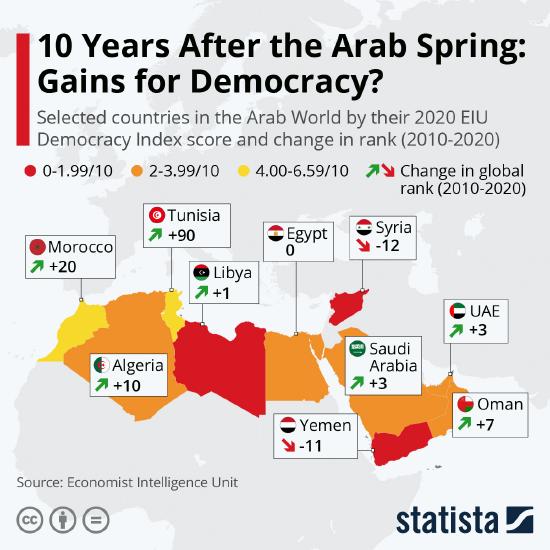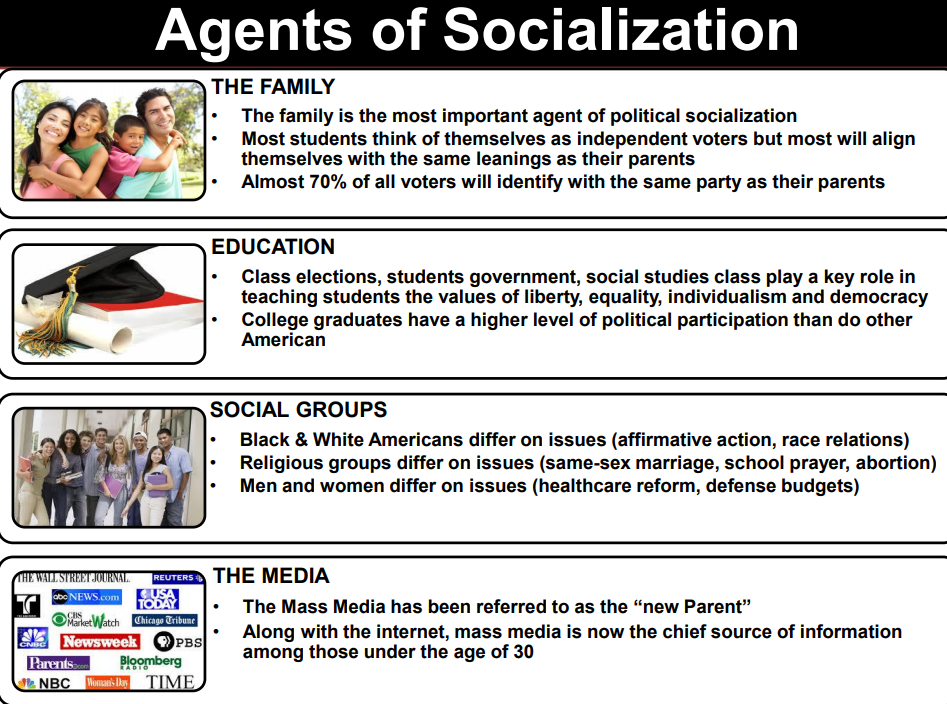6.1: Introduction to Political Identity
- Last updated
- Save as PDF
- Page ID
- 150453
Learning Objectives
By the end of this section, you will be able to:
- Define political identity and related terms such as political socialization and political mobilization of identity.
- Identify the ways in which individuals undergo political socialization towards the formation of political identity.
- Consider the connections between political identity and political mobilization.
Political Identity and Related Terms
Identity can answer several questions, 'Who am I?' 'How do I want to be seen by others? 'How do I want to be seen in the future?' A person’s identity is developed from a combination of factors, including a person’s experiences, relationships, perception of the world, calculation of risk and threat in the world, as well as their observations and experience of societal mores, morals, and values. Sometimes, identity can take characteristics for which people have no actual control, like a person’s race, height, eye color, socio-economic class, and so forth. In all cases, identity forms through a process of socialization, where the individual discovers themselves and where they think they fit within the social order.
Identity, and the calculation of one’s identity, can section people into groups of 'sameness' and 'differentness'. As a consequence, the development and outcomes of identity shape the world around us and the conflicts that arise. It can also help us understand history and past conflicts.
Not surprisingly, the term political identity shares almost all of the same traits as the term identity itself. The questions of 'Who am I?' and 'How do I want to be seen by others,' are answered using political orientations. In other words, political identity is defined as how a person or group of persons think of themselves in relation to the politics and government of a country. It refers to the labels and characteristics an individual chooses to associate with based on a multitude of factors including but not limited to, their perception of political ideologies, platforms and parties, as well as how they see themselves from national, racial, ethnic, linguistic, cultural and gender perspectives.
Over the past two decades, political scientists have considered many political identities, some rooted in biology and genetics (race, biological gender, etc.) and others being rooted in symbolic, religious, and patriotic origins. (For instance, being born a certain race and identifying with that race versus deciding to belong to a religious group of one’s own volition).
Political scientists have begun focusing on political identity because human attachment to these identities has been mobilized for/with political consequences. Political mobilization is organized activities intended to motivate groups of participants to take political action on a particular issue. Two examples are included below.
Occurring in 2010, the Arab Spring was a series of protests against oppressive government regions in Bahrain, Saudi Arabia, Egypt, Libya, Syria, Tunisia, the United Arab Emirates, and Yemen, sometimes resulting in violence. The protesters tended to be from two main identity groups: the country’s youth or young people who were dissatisfied with authoritative regimes and wanted democratic governments or the Unions that were under constant threat. In this circumstance, the identity of the younger population, as well as those belonging to Unions, was mobilized to demand change. Though there is still conflict in all of these countries, the Arab Spring is said to have ended in 2012. According to political scientists, the countries which did not have oil and/or oil wealth were much more likely to undergo regime transition as a result of these protests than those countries that were oil-rich.

Source: Statista
Another more recent example is the January 6, 2021, Insurrection at the US Capitol Building where approximately 2,000- 2,500 supporters of then President Donald Trump attempted to violently overturn the 2020 election results showing that Joseph Biden won the presidency. These protests were planned and instigated by a number of Trump supporters who identified with a faction within the Republican Party. This group believed there was widespread election fraud and corruption in the 2020 Presidential Election. By organizing through social media, and attending Trump’s speech that same morning, the protestors mobilized their collective political identity, marched to the Capitol, attacked and infiltrated the building, assaulted law enforcement officers, vandalized property, and stayed on the premises for hours. Five people died and over 130 police officers were injured. Some have alleged that Trump’s speech was intended to incite violence, though proving speech invokes action can be difficult to do. An excerpt from Trump’s speech was:
All of us here today do not want to see our election victory stolen by emboldened radical-left Democrats, which is what they're doing. And stolen by the fake news media. That's what they've done and what they're doing. We will never give up, we will never concede. It doesn't happen. You don't concede when there's theft involved. Our country has had enough. We will not take it anymore and that's what this is all about. And to use a favorite term that all of you people really came up with: We will stop the steal. [Speech by Donald Trump during the January 6th 2021 United States Capitol Attack] (Naylor, 2021)
The Process of Political Socialization
Political identity is often a key factor to consider for the formation of states, as well as in the context of causes for conflict. If a state’s population is fairly homogeneous, or similar in identity, it may be easier to have laws and policies that align with the political identity of the people. If a population is heterogeneous, or different in identities, there may be more conflict and less ability to unite people under similar laws and norms. A diverse society can be a peaceful or efficient one, but when identities are different enough in terms of values and concerns, conflict is more likely to arise. For example, in India, state formation was a challenge in part due to the variety of political identities that existed with potentially different religions, ethnicities, values, and beliefs.
How is political identity formed? Where does one’s political identity come from? Society refers to a population that has organized itself based on shared ideas for how the world acts and should act through both formal and informal institutions. Thus, political socialization is the process by which our political beliefs are formed over time. It is how individuals perceive the political world around them, come to understand how society is organized, and how they see their own role in society based on these perceptions.
Some aspects of identity tend to be fixed, such as race and biological sex (which will be discussed in the following chapters). Biological factors tend to be stationary factors out of an individual’s control. Identity can also be formed based on symbolic meaning, ideology, gender, religion, and culture. Regardless of whether the aspects of identity are fixed or dynamic, the process of socialization can be influenced and formed through a number of different actors/institutions in a person’s life.
- Families, such as mom, dad, parental guardian, or mentor, share their beliefs and perceptions about society with a child. In some ways, whether a child adopts the same views as their parents, guardians or mentors may depend on whether the child truly recognizes these actors as legitimate with authority. In other words, if the child recognizes these actors as legitimate sources of authority, they may be inclined to adopt similar perspectives. If a child does not see these agents as legitimate, they may adopt opposing stances.
- Schools are institutions that provide students with information about the world around them. In a number of countries worldwide, schools provide structured and standardized education to address core subjects that society has deemed important. In the United States, students may take mathematics, science, English, reading, social studies, and writing, as well as electives like art, computers, shop class, drama, automotive, and so forth. Teachers can have a huge impact on what a student walks away thinking about a certain subject or course. In some ways, what a student thinks of what a teacher says can be similar to what a child thinks of their parent, guardian, or mentor. The individual will ask themselves: Do I trust this person? Do I think this person knows what they are talking about? If students do trust the person and believe the teacher knows what they are talking about, a student may adopt similar views and beliefs as this person. Conversely, if the student does not trust or believe in the teacher, they may adopt opposing views. Oftentimes, younger students will be more likely to trust those who are teaching. But, as adolescence arrives, they will begin to ask these questions more critically.
- Friends and peers are also agents of socialization. Adolescents are more influenced by their friends and peers than when they were younger. Some research has shown peer influences may not be representative or predictive of the political identity that adolescents form later on in life. However, in the short term, adolescent youths will be influenced by their peers' thoughts, ideas, attitudes, and beliefs in an attempt to fit in or please their friends.
- Over the last 40 years, the media’s influence has grown substantially around the world. In the late 20th century, news in the United States largely took place at one time of day, 6 pm, with local news at 10 pm. Today, the news is broadcasted every hour of every day in a 24-hour news cycle. News can offer political judgement based on political ideological leanings, speaking more from the perspective of an ideology rather than a position of complete objectivity.
In addition, social media platforms have given individuals the ability to have near real-time knowledge of what is going around in the world around them as well as the ability to project out their own thoughts, beliefs, and judgments. Although readily available, opinions are not always edited, managed, corrected, or deemed accurate by any overarching source to manage public perceptions. This action can be both a good and bad thing for political socialization as well as democracy. Freedom of speech is one of the cornerstones of democracy. However, the elevation of opinions to broadcasting status can amplify judgments that are not based on facts or scholastic reviews. This lack of accountability has translated into a dangerous situation where opinions can be viewed as fact with very little evidence to support or validate the opinion. All of these factors do, for better or worse, shape a person’s political identity.
- Religion can be a powerful force in the lives of many people. In the United States alone, more than 80% of the citizens say they believe in a 'higher power', according to one large sample survey data. Keep in mind that this data does not mean that US citizens are similar in religion and religious values. In 2020, 65% of US citizens said they were Christian (a number that has been in steep decline for the last five decades), and only 40% of Americans said religion was important in their lives. Within the US, there are major divisions, particularly between the majority Protestant population and the minority Catholic population. Other religious belief systems represented in the US include Mormonism, Buddhism, Muslim, Hinduism, Agnostic, and Atheist. For those who do attend church or participate in religious activities or events, individuals can begin to view political factors from religious, spiritual, or moralistic lenses.
- What the government itself says or does and how individuals perceive their actions and values in the context of their greater society are important.
Agents of Socialization in the United States
While agents of socialization occur in all countries and cultures, how they apply to political events, ideologies, and applications may differ. This graphic shows how agents of socialization might appear in the United States regarding key issues.

Source: Ms. Newell's AP US Government Course @Prince William County Public School District, Virginia.

